Critical Thinking in Tertiary Education: Benefits and Challenges
VerifiedAdded on 2020/02/24
|9
|1984
|114
Essay
AI Summary
This essay delves into the crucial role of critical thinking in tertiary education, arguing that it is a vital skill often lacking in students. It defines critical thinking as a process of logical and clear thinking, essential for interpreting, reasoning, and analyzing information. The essay highlights the benefits of critical thinking in tertiary studies, including improved academic performance, enhanced knowledge skills, and the ability to challenge societal structures. It emphasizes the importance of integrating critical thinking into the curriculum and the need for teachers to foster these skills. The essay also discusses the value of tertiary education in preparing students for the workforce and contributing to society, concluding that critical thinking is essential for navigating the complexities of a globalized world and making informed decisions.
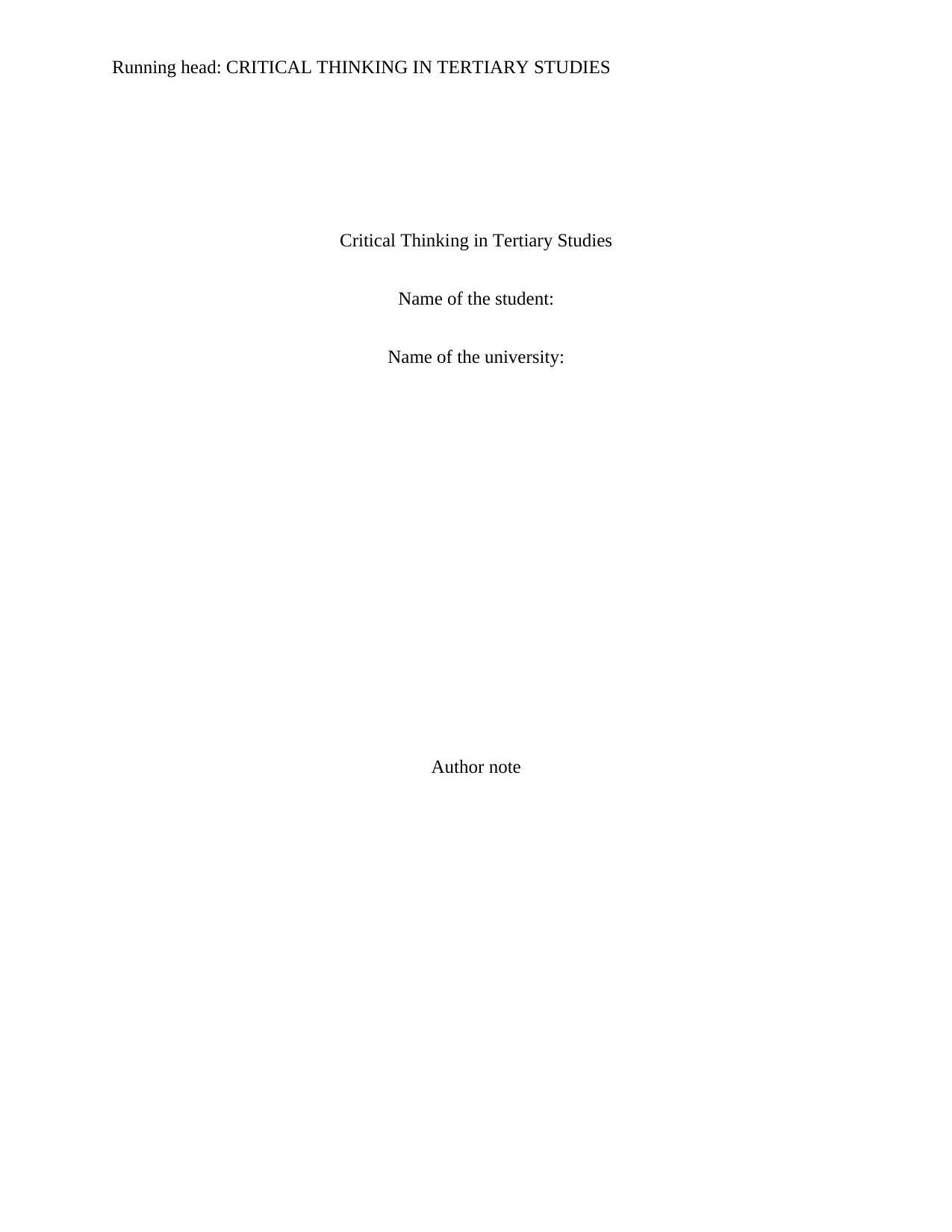
Running head: CRITICAL THINKING IN TERTIARY STUDIES
Critical Thinking in Tertiary Studies
Name of the student:
Name of the university:
Author note
Critical Thinking in Tertiary Studies
Name of the student:
Name of the university:
Author note
Paraphrase This Document
Need a fresh take? Get an instant paraphrase of this document with our AI Paraphraser
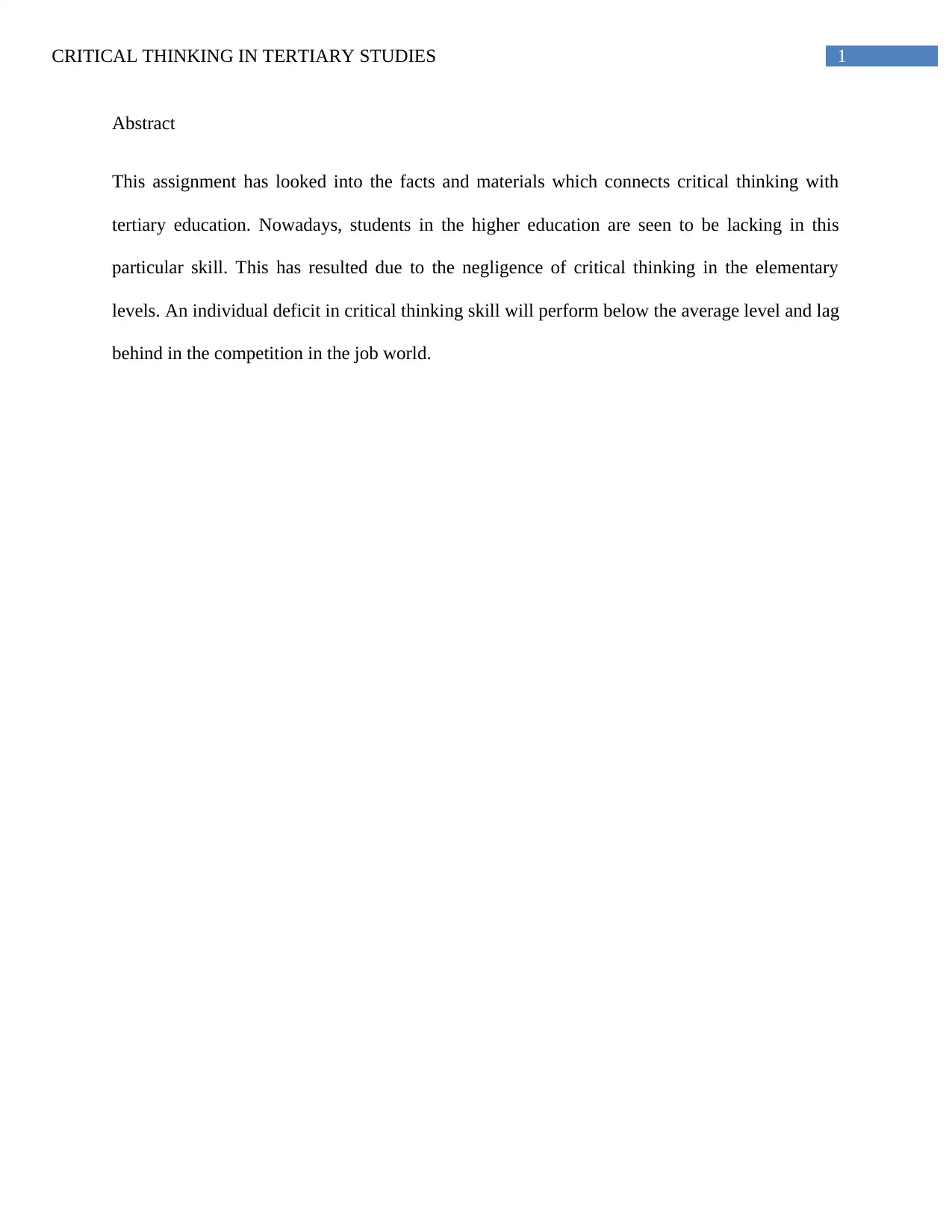
1CRITICAL THINKING IN TERTIARY STUDIES
Abstract
This assignment has looked into the facts and materials which connects critical thinking with
tertiary education. Nowadays, students in the higher education are seen to be lacking in this
particular skill. This has resulted due to the negligence of critical thinking in the elementary
levels. An individual deficit in critical thinking skill will perform below the average level and lag
behind in the competition in the job world.
Abstract
This assignment has looked into the facts and materials which connects critical thinking with
tertiary education. Nowadays, students in the higher education are seen to be lacking in this
particular skill. This has resulted due to the negligence of critical thinking in the elementary
levels. An individual deficit in critical thinking skill will perform below the average level and lag
behind in the competition in the job world.
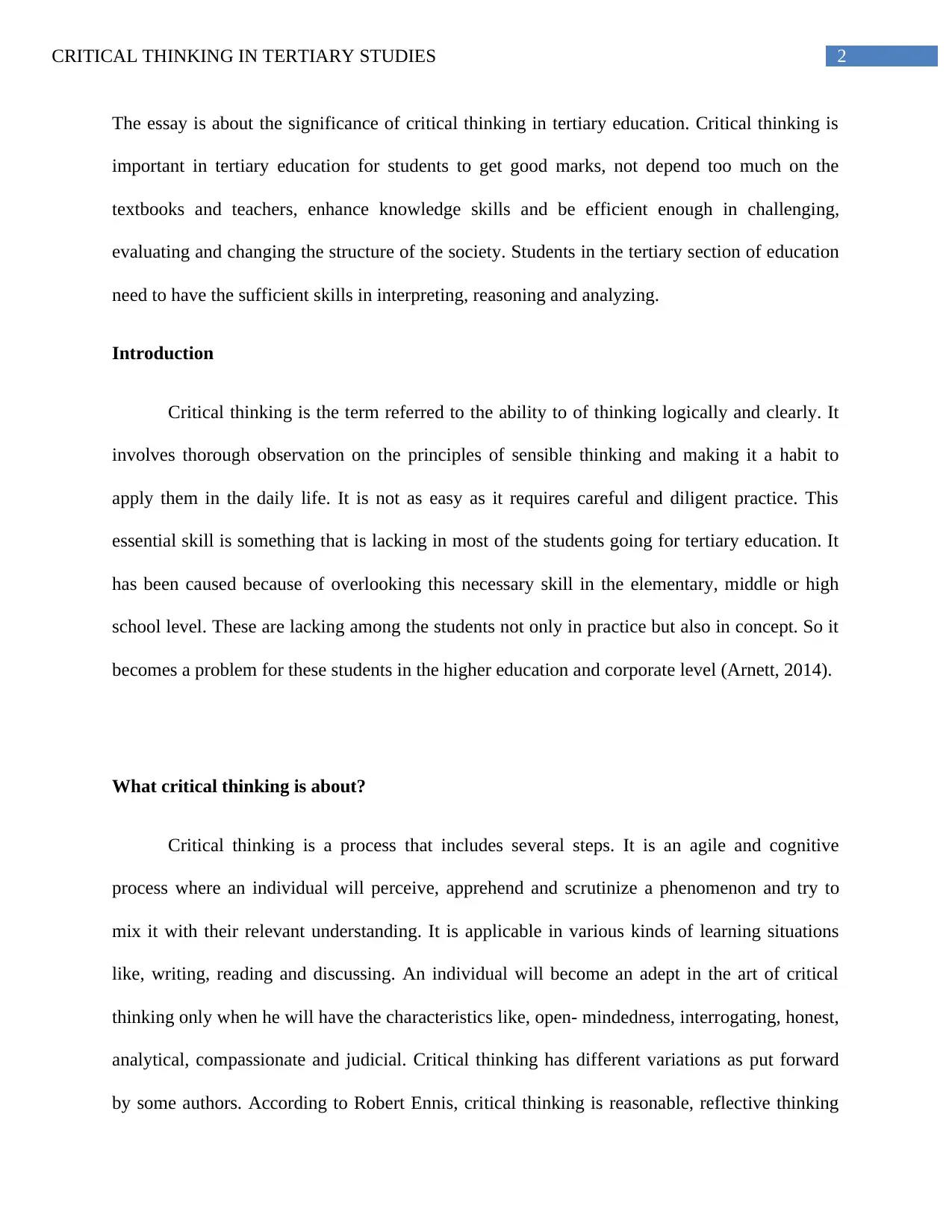
2CRITICAL THINKING IN TERTIARY STUDIES
The essay is about the significance of critical thinking in tertiary education. Critical thinking is
important in tertiary education for students to get good marks, not depend too much on the
textbooks and teachers, enhance knowledge skills and be efficient enough in challenging,
evaluating and changing the structure of the society. Students in the tertiary section of education
need to have the sufficient skills in interpreting, reasoning and analyzing.
Introduction
Critical thinking is the term referred to the ability to of thinking logically and clearly. It
involves thorough observation on the principles of sensible thinking and making it a habit to
apply them in the daily life. It is not as easy as it requires careful and diligent practice. This
essential skill is something that is lacking in most of the students going for tertiary education. It
has been caused because of overlooking this necessary skill in the elementary, middle or high
school level. These are lacking among the students not only in practice but also in concept. So it
becomes a problem for these students in the higher education and corporate level (Arnett, 2014).
What critical thinking is about?
Critical thinking is a process that includes several steps. It is an agile and cognitive
process where an individual will perceive, apprehend and scrutinize a phenomenon and try to
mix it with their relevant understanding. It is applicable in various kinds of learning situations
like, writing, reading and discussing. An individual will become an adept in the art of critical
thinking only when he will have the characteristics like, open- mindedness, interrogating, honest,
analytical, compassionate and judicial. Critical thinking has different variations as put forward
by some authors. According to Robert Ennis, critical thinking is reasonable, reflective thinking
The essay is about the significance of critical thinking in tertiary education. Critical thinking is
important in tertiary education for students to get good marks, not depend too much on the
textbooks and teachers, enhance knowledge skills and be efficient enough in challenging,
evaluating and changing the structure of the society. Students in the tertiary section of education
need to have the sufficient skills in interpreting, reasoning and analyzing.
Introduction
Critical thinking is the term referred to the ability to of thinking logically and clearly. It
involves thorough observation on the principles of sensible thinking and making it a habit to
apply them in the daily life. It is not as easy as it requires careful and diligent practice. This
essential skill is something that is lacking in most of the students going for tertiary education. It
has been caused because of overlooking this necessary skill in the elementary, middle or high
school level. These are lacking among the students not only in practice but also in concept. So it
becomes a problem for these students in the higher education and corporate level (Arnett, 2014).
What critical thinking is about?
Critical thinking is a process that includes several steps. It is an agile and cognitive
process where an individual will perceive, apprehend and scrutinize a phenomenon and try to
mix it with their relevant understanding. It is applicable in various kinds of learning situations
like, writing, reading and discussing. An individual will become an adept in the art of critical
thinking only when he will have the characteristics like, open- mindedness, interrogating, honest,
analytical, compassionate and judicial. Critical thinking has different variations as put forward
by some authors. According to Robert Ennis, critical thinking is reasonable, reflective thinking
⊘ This is a preview!⊘
Do you want full access?
Subscribe today to unlock all pages.

Trusted by 1+ million students worldwide
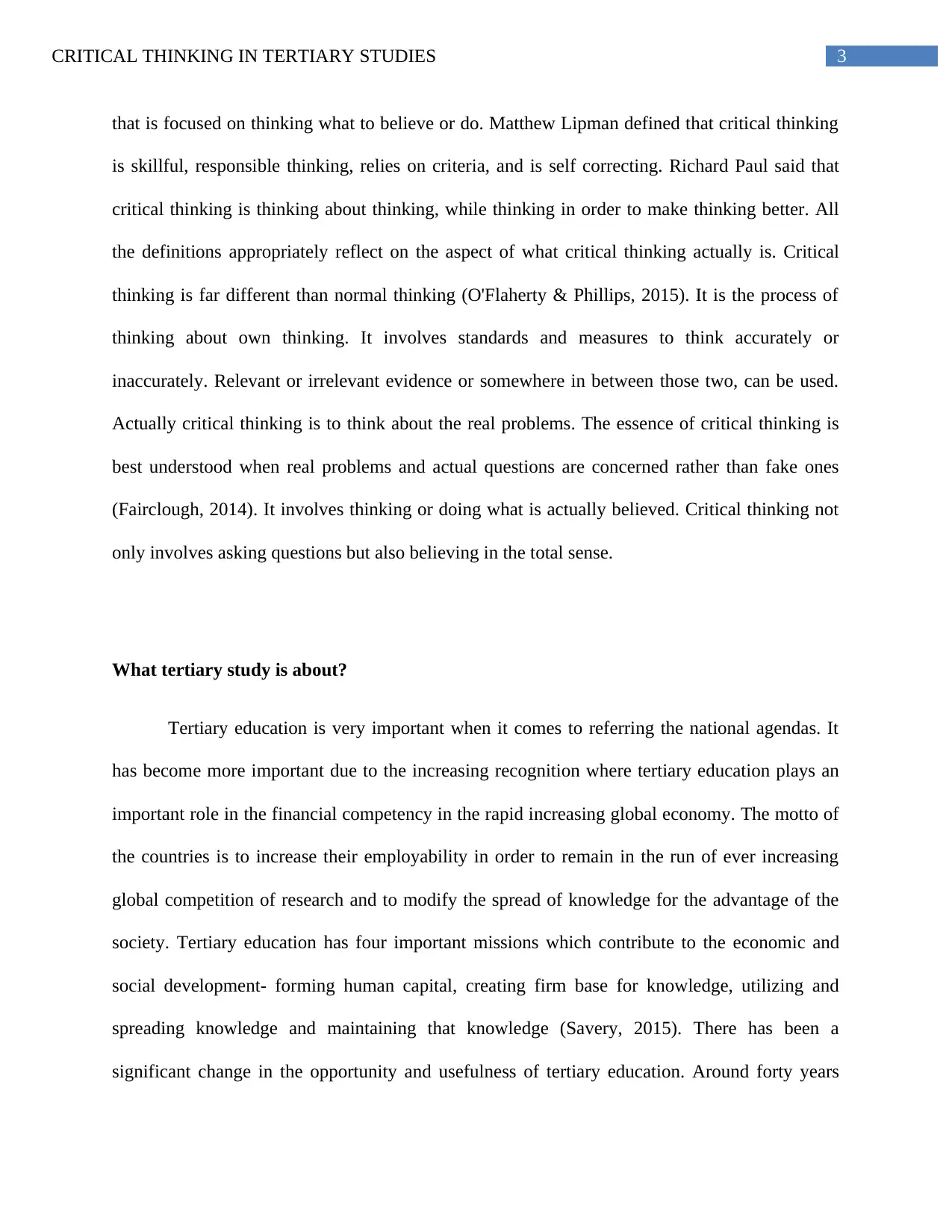
3CRITICAL THINKING IN TERTIARY STUDIES
that is focused on thinking what to believe or do. Matthew Lipman defined that critical thinking
is skillful, responsible thinking, relies on criteria, and is self correcting. Richard Paul said that
critical thinking is thinking about thinking, while thinking in order to make thinking better. All
the definitions appropriately reflect on the aspect of what critical thinking actually is. Critical
thinking is far different than normal thinking (O'Flaherty & Phillips, 2015). It is the process of
thinking about own thinking. It involves standards and measures to think accurately or
inaccurately. Relevant or irrelevant evidence or somewhere in between those two, can be used.
Actually critical thinking is to think about the real problems. The essence of critical thinking is
best understood when real problems and actual questions are concerned rather than fake ones
(Fairclough, 2014). It involves thinking or doing what is actually believed. Critical thinking not
only involves asking questions but also believing in the total sense.
What tertiary study is about?
Tertiary education is very important when it comes to referring the national agendas. It
has become more important due to the increasing recognition where tertiary education plays an
important role in the financial competency in the rapid increasing global economy. The motto of
the countries is to increase their employability in order to remain in the run of ever increasing
global competition of research and to modify the spread of knowledge for the advantage of the
society. Tertiary education has four important missions which contribute to the economic and
social development- forming human capital, creating firm base for knowledge, utilizing and
spreading knowledge and maintaining that knowledge (Savery, 2015). There has been a
significant change in the opportunity and usefulness of tertiary education. Around forty years
that is focused on thinking what to believe or do. Matthew Lipman defined that critical thinking
is skillful, responsible thinking, relies on criteria, and is self correcting. Richard Paul said that
critical thinking is thinking about thinking, while thinking in order to make thinking better. All
the definitions appropriately reflect on the aspect of what critical thinking actually is. Critical
thinking is far different than normal thinking (O'Flaherty & Phillips, 2015). It is the process of
thinking about own thinking. It involves standards and measures to think accurately or
inaccurately. Relevant or irrelevant evidence or somewhere in between those two, can be used.
Actually critical thinking is to think about the real problems. The essence of critical thinking is
best understood when real problems and actual questions are concerned rather than fake ones
(Fairclough, 2014). It involves thinking or doing what is actually believed. Critical thinking not
only involves asking questions but also believing in the total sense.
What tertiary study is about?
Tertiary education is very important when it comes to referring the national agendas. It
has become more important due to the increasing recognition where tertiary education plays an
important role in the financial competency in the rapid increasing global economy. The motto of
the countries is to increase their employability in order to remain in the run of ever increasing
global competition of research and to modify the spread of knowledge for the advantage of the
society. Tertiary education has four important missions which contribute to the economic and
social development- forming human capital, creating firm base for knowledge, utilizing and
spreading knowledge and maintaining that knowledge (Savery, 2015). There has been a
significant change in the opportunity and usefulness of tertiary education. Around forty years
Paraphrase This Document
Need a fresh take? Get an instant paraphrase of this document with our AI Paraphraser
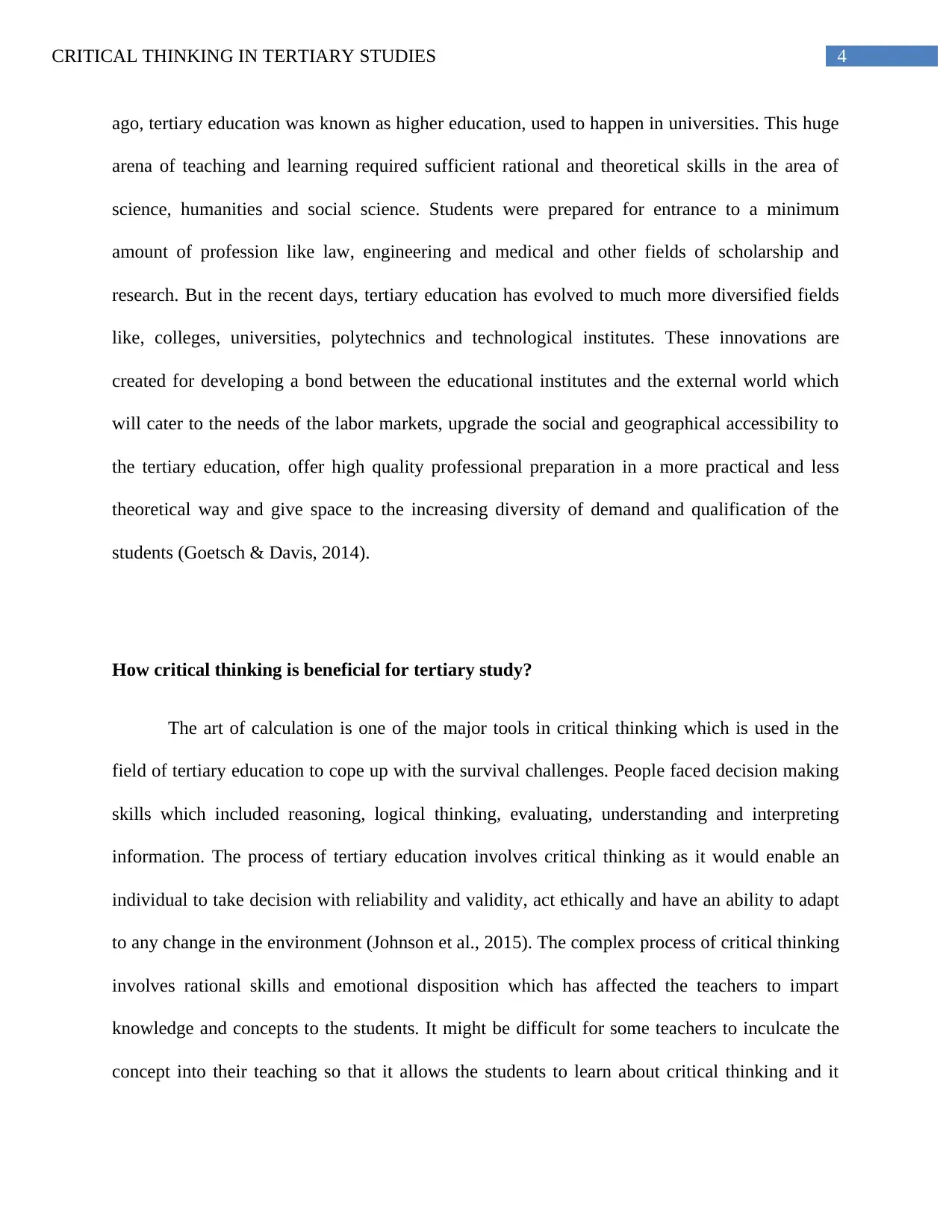
4CRITICAL THINKING IN TERTIARY STUDIES
ago, tertiary education was known as higher education, used to happen in universities. This huge
arena of teaching and learning required sufficient rational and theoretical skills in the area of
science, humanities and social science. Students were prepared for entrance to a minimum
amount of profession like law, engineering and medical and other fields of scholarship and
research. But in the recent days, tertiary education has evolved to much more diversified fields
like, colleges, universities, polytechnics and technological institutes. These innovations are
created for developing a bond between the educational institutes and the external world which
will cater to the needs of the labor markets, upgrade the social and geographical accessibility to
the tertiary education, offer high quality professional preparation in a more practical and less
theoretical way and give space to the increasing diversity of demand and qualification of the
students (Goetsch & Davis, 2014).
How critical thinking is beneficial for tertiary study?
The art of calculation is one of the major tools in critical thinking which is used in the
field of tertiary education to cope up with the survival challenges. People faced decision making
skills which included reasoning, logical thinking, evaluating, understanding and interpreting
information. The process of tertiary education involves critical thinking as it would enable an
individual to take decision with reliability and validity, act ethically and have an ability to adapt
to any change in the environment (Johnson et al., 2015). The complex process of critical thinking
involves rational skills and emotional disposition which has affected the teachers to impart
knowledge and concepts to the students. It might be difficult for some teachers to inculcate the
concept into their teaching so that it allows the students to learn about critical thinking and it
ago, tertiary education was known as higher education, used to happen in universities. This huge
arena of teaching and learning required sufficient rational and theoretical skills in the area of
science, humanities and social science. Students were prepared for entrance to a minimum
amount of profession like law, engineering and medical and other fields of scholarship and
research. But in the recent days, tertiary education has evolved to much more diversified fields
like, colleges, universities, polytechnics and technological institutes. These innovations are
created for developing a bond between the educational institutes and the external world which
will cater to the needs of the labor markets, upgrade the social and geographical accessibility to
the tertiary education, offer high quality professional preparation in a more practical and less
theoretical way and give space to the increasing diversity of demand and qualification of the
students (Goetsch & Davis, 2014).
How critical thinking is beneficial for tertiary study?
The art of calculation is one of the major tools in critical thinking which is used in the
field of tertiary education to cope up with the survival challenges. People faced decision making
skills which included reasoning, logical thinking, evaluating, understanding and interpreting
information. The process of tertiary education involves critical thinking as it would enable an
individual to take decision with reliability and validity, act ethically and have an ability to adapt
to any change in the environment (Johnson et al., 2015). The complex process of critical thinking
involves rational skills and emotional disposition which has affected the teachers to impart
knowledge and concepts to the students. It might be difficult for some teachers to inculcate the
concept into their teaching so that it allows the students to learn about critical thinking and it
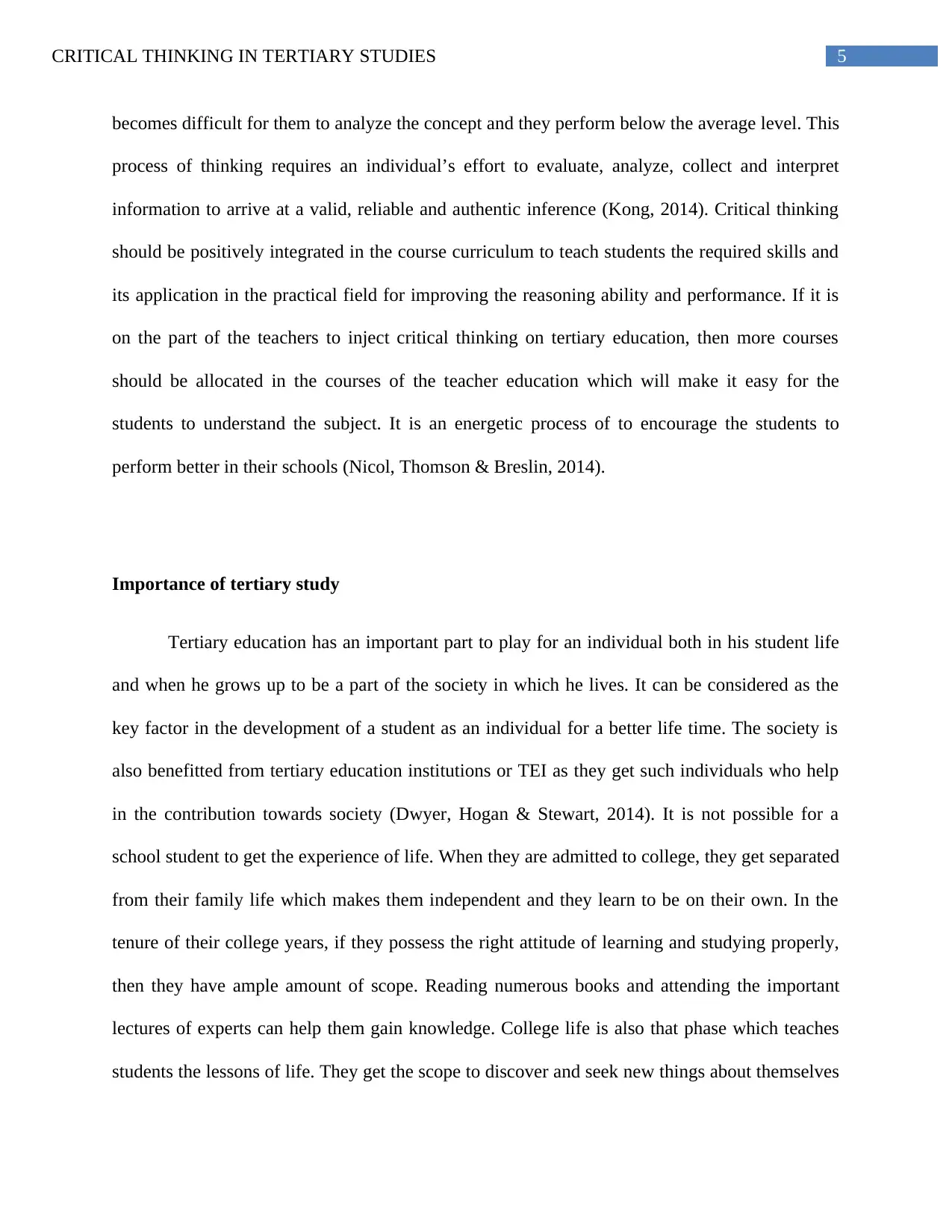
5CRITICAL THINKING IN TERTIARY STUDIES
becomes difficult for them to analyze the concept and they perform below the average level. This
process of thinking requires an individual’s effort to evaluate, analyze, collect and interpret
information to arrive at a valid, reliable and authentic inference (Kong, 2014). Critical thinking
should be positively integrated in the course curriculum to teach students the required skills and
its application in the practical field for improving the reasoning ability and performance. If it is
on the part of the teachers to inject critical thinking on tertiary education, then more courses
should be allocated in the courses of the teacher education which will make it easy for the
students to understand the subject. It is an energetic process of to encourage the students to
perform better in their schools (Nicol, Thomson & Breslin, 2014).
Importance of tertiary study
Tertiary education has an important part to play for an individual both in his student life
and when he grows up to be a part of the society in which he lives. It can be considered as the
key factor in the development of a student as an individual for a better life time. The society is
also benefitted from tertiary education institutions or TEI as they get such individuals who help
in the contribution towards society (Dwyer, Hogan & Stewart, 2014). It is not possible for a
school student to get the experience of life. When they are admitted to college, they get separated
from their family life which makes them independent and they learn to be on their own. In the
tenure of their college years, if they possess the right attitude of learning and studying properly,
then they have ample amount of scope. Reading numerous books and attending the important
lectures of experts can help them gain knowledge. College life is also that phase which teaches
students the lessons of life. They get the scope to discover and seek new things about themselves
becomes difficult for them to analyze the concept and they perform below the average level. This
process of thinking requires an individual’s effort to evaluate, analyze, collect and interpret
information to arrive at a valid, reliable and authentic inference (Kong, 2014). Critical thinking
should be positively integrated in the course curriculum to teach students the required skills and
its application in the practical field for improving the reasoning ability and performance. If it is
on the part of the teachers to inject critical thinking on tertiary education, then more courses
should be allocated in the courses of the teacher education which will make it easy for the
students to understand the subject. It is an energetic process of to encourage the students to
perform better in their schools (Nicol, Thomson & Breslin, 2014).
Importance of tertiary study
Tertiary education has an important part to play for an individual both in his student life
and when he grows up to be a part of the society in which he lives. It can be considered as the
key factor in the development of a student as an individual for a better life time. The society is
also benefitted from tertiary education institutions or TEI as they get such individuals who help
in the contribution towards society (Dwyer, Hogan & Stewart, 2014). It is not possible for a
school student to get the experience of life. When they are admitted to college, they get separated
from their family life which makes them independent and they learn to be on their own. In the
tenure of their college years, if they possess the right attitude of learning and studying properly,
then they have ample amount of scope. Reading numerous books and attending the important
lectures of experts can help them gain knowledge. College life is also that phase which teaches
students the lessons of life. They get the scope to discover and seek new things about themselves
⊘ This is a preview!⊘
Do you want full access?
Subscribe today to unlock all pages.

Trusted by 1+ million students worldwide
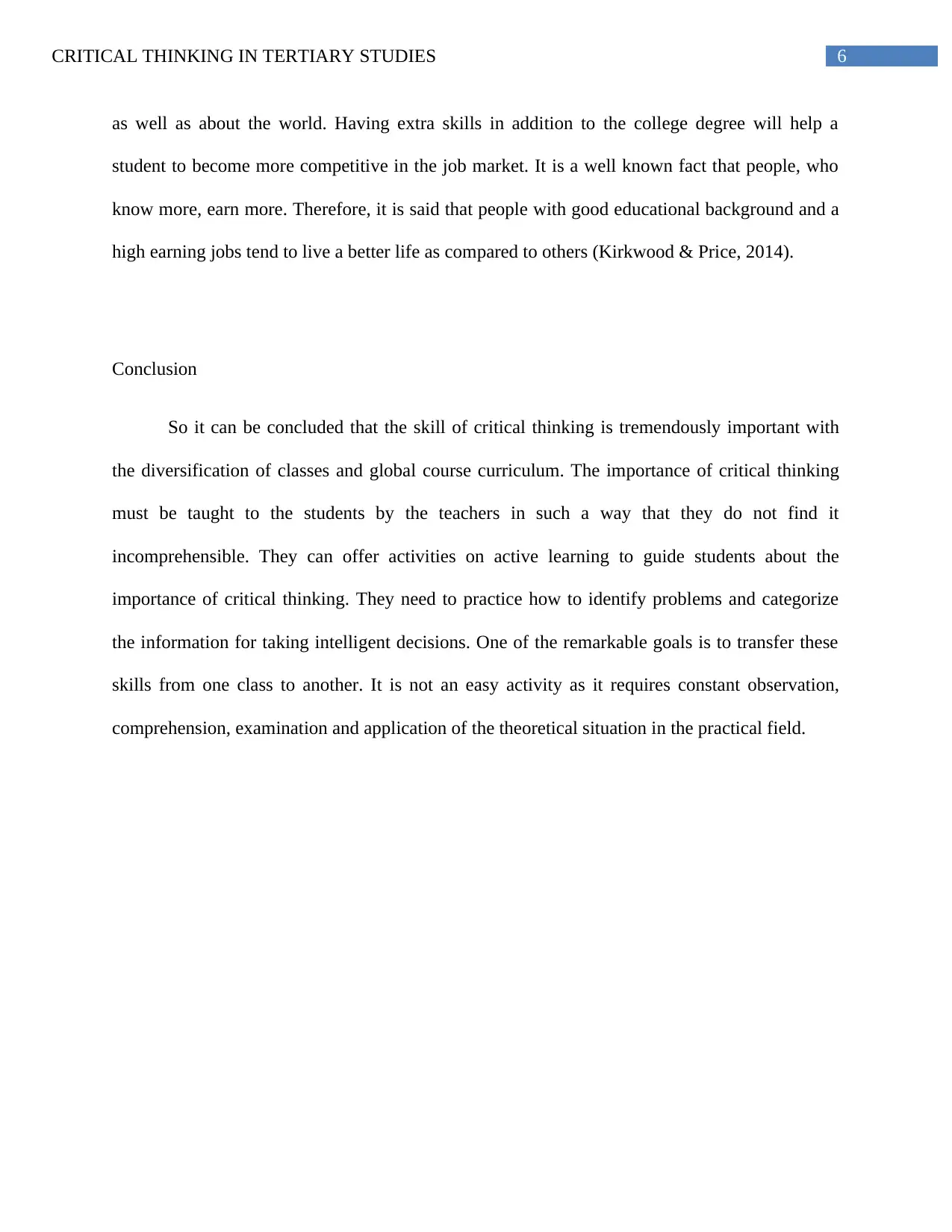
6CRITICAL THINKING IN TERTIARY STUDIES
as well as about the world. Having extra skills in addition to the college degree will help a
student to become more competitive in the job market. It is a well known fact that people, who
know more, earn more. Therefore, it is said that people with good educational background and a
high earning jobs tend to live a better life as compared to others (Kirkwood & Price, 2014).
Conclusion
So it can be concluded that the skill of critical thinking is tremendously important with
the diversification of classes and global course curriculum. The importance of critical thinking
must be taught to the students by the teachers in such a way that they do not find it
incomprehensible. They can offer activities on active learning to guide students about the
importance of critical thinking. They need to practice how to identify problems and categorize
the information for taking intelligent decisions. One of the remarkable goals is to transfer these
skills from one class to another. It is not an easy activity as it requires constant observation,
comprehension, examination and application of the theoretical situation in the practical field.
as well as about the world. Having extra skills in addition to the college degree will help a
student to become more competitive in the job market. It is a well known fact that people, who
know more, earn more. Therefore, it is said that people with good educational background and a
high earning jobs tend to live a better life as compared to others (Kirkwood & Price, 2014).
Conclusion
So it can be concluded that the skill of critical thinking is tremendously important with
the diversification of classes and global course curriculum. The importance of critical thinking
must be taught to the students by the teachers in such a way that they do not find it
incomprehensible. They can offer activities on active learning to guide students about the
importance of critical thinking. They need to practice how to identify problems and categorize
the information for taking intelligent decisions. One of the remarkable goals is to transfer these
skills from one class to another. It is not an easy activity as it requires constant observation,
comprehension, examination and application of the theoretical situation in the practical field.
Paraphrase This Document
Need a fresh take? Get an instant paraphrase of this document with our AI Paraphraser
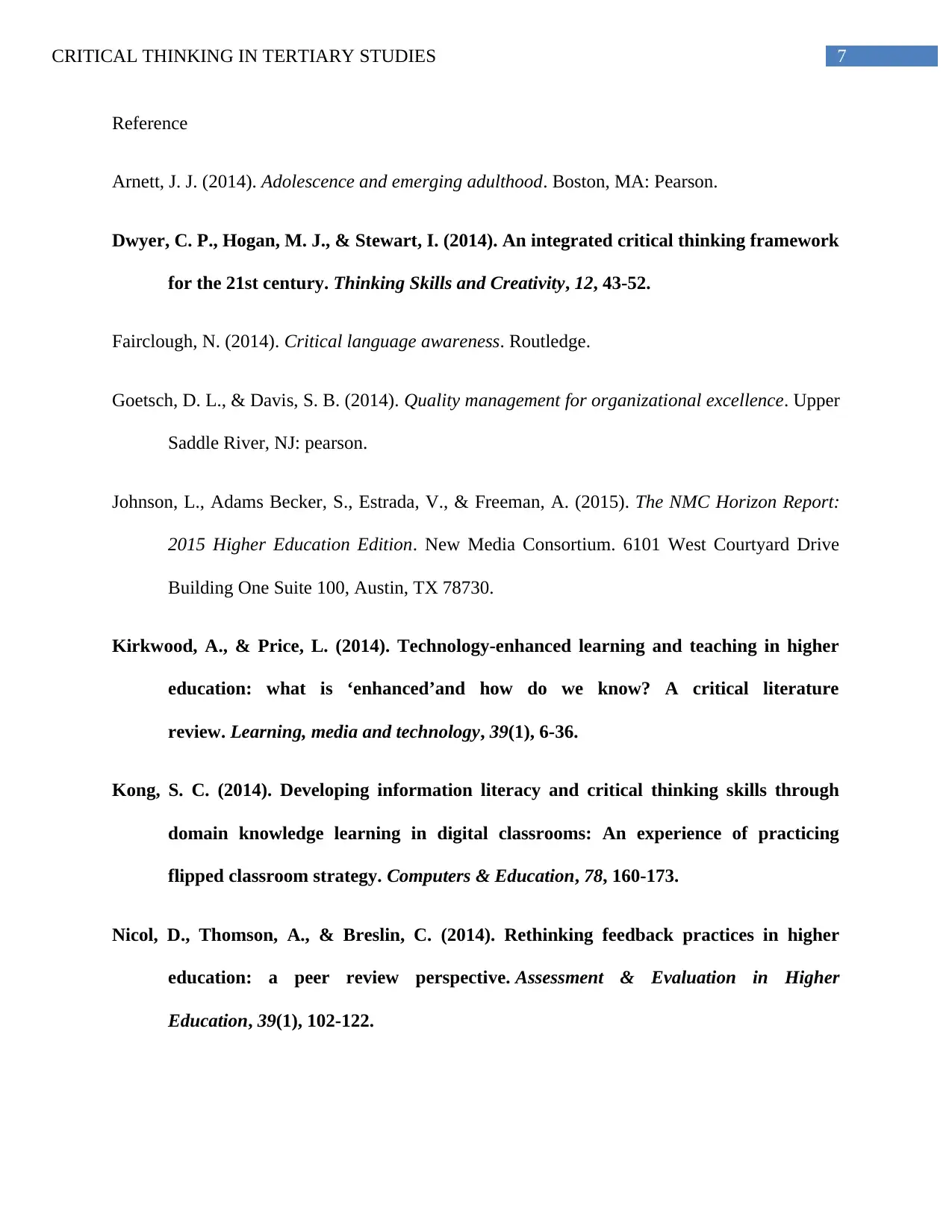
7CRITICAL THINKING IN TERTIARY STUDIES
Reference
Arnett, J. J. (2014). Adolescence and emerging adulthood. Boston, MA: Pearson.
Dwyer, C. P., Hogan, M. J., & Stewart, I. (2014). An integrated critical thinking framework
for the 21st century. Thinking Skills and Creativity, 12, 43-52.
Fairclough, N. (2014). Critical language awareness. Routledge.
Goetsch, D. L., & Davis, S. B. (2014). Quality management for organizational excellence. Upper
Saddle River, NJ: pearson.
Johnson, L., Adams Becker, S., Estrada, V., & Freeman, A. (2015). The NMC Horizon Report:
2015 Higher Education Edition. New Media Consortium. 6101 West Courtyard Drive
Building One Suite 100, Austin, TX 78730.
Kirkwood, A., & Price, L. (2014). Technology-enhanced learning and teaching in higher
education: what is ‘enhanced’and how do we know? A critical literature
review. Learning, media and technology, 39(1), 6-36.
Kong, S. C. (2014). Developing information literacy and critical thinking skills through
domain knowledge learning in digital classrooms: An experience of practicing
flipped classroom strategy. Computers & Education, 78, 160-173.
Nicol, D., Thomson, A., & Breslin, C. (2014). Rethinking feedback practices in higher
education: a peer review perspective. Assessment & Evaluation in Higher
Education, 39(1), 102-122.
Reference
Arnett, J. J. (2014). Adolescence and emerging adulthood. Boston, MA: Pearson.
Dwyer, C. P., Hogan, M. J., & Stewart, I. (2014). An integrated critical thinking framework
for the 21st century. Thinking Skills and Creativity, 12, 43-52.
Fairclough, N. (2014). Critical language awareness. Routledge.
Goetsch, D. L., & Davis, S. B. (2014). Quality management for organizational excellence. Upper
Saddle River, NJ: pearson.
Johnson, L., Adams Becker, S., Estrada, V., & Freeman, A. (2015). The NMC Horizon Report:
2015 Higher Education Edition. New Media Consortium. 6101 West Courtyard Drive
Building One Suite 100, Austin, TX 78730.
Kirkwood, A., & Price, L. (2014). Technology-enhanced learning and teaching in higher
education: what is ‘enhanced’and how do we know? A critical literature
review. Learning, media and technology, 39(1), 6-36.
Kong, S. C. (2014). Developing information literacy and critical thinking skills through
domain knowledge learning in digital classrooms: An experience of practicing
flipped classroom strategy. Computers & Education, 78, 160-173.
Nicol, D., Thomson, A., & Breslin, C. (2014). Rethinking feedback practices in higher
education: a peer review perspective. Assessment & Evaluation in Higher
Education, 39(1), 102-122.
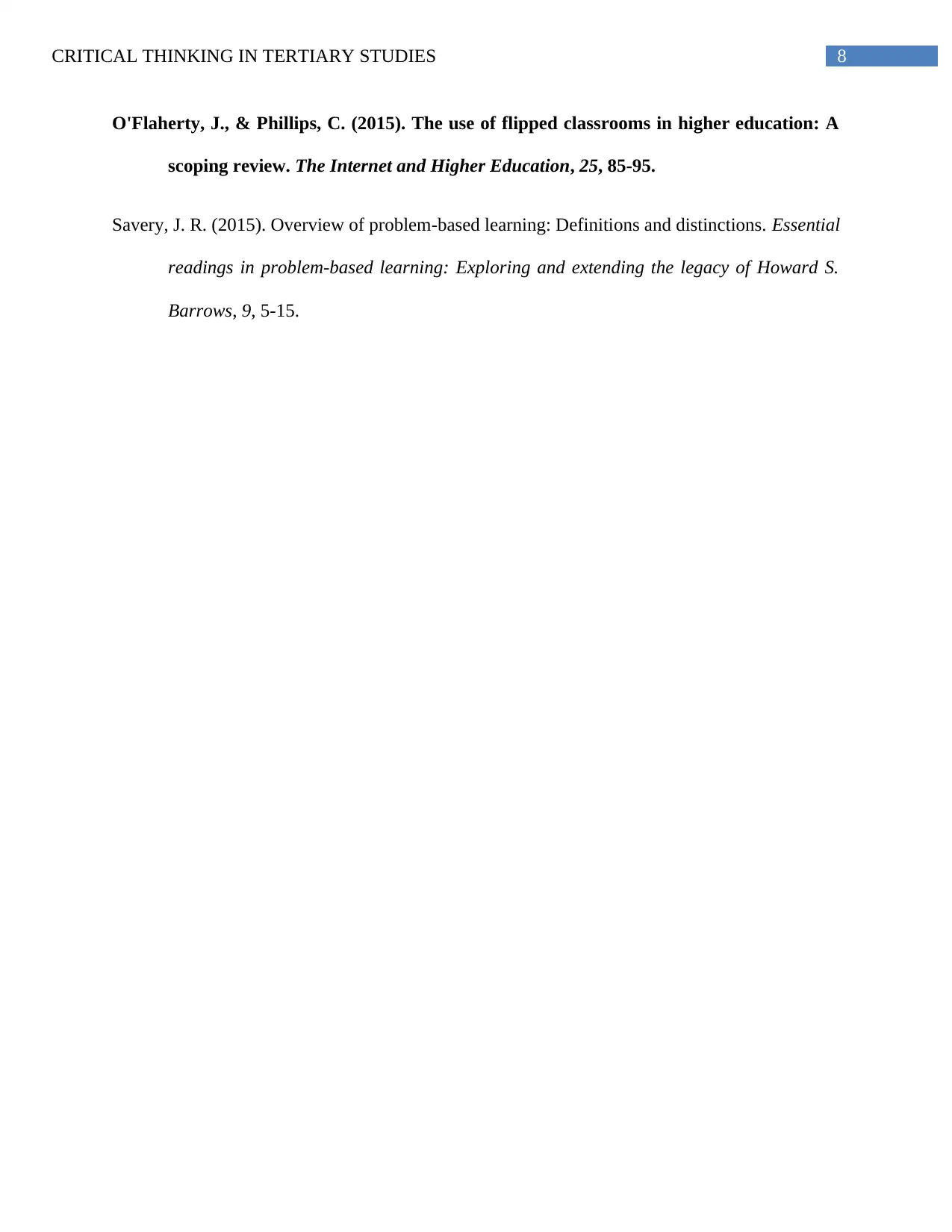
8CRITICAL THINKING IN TERTIARY STUDIES
O'Flaherty, J., & Phillips, C. (2015). The use of flipped classrooms in higher education: A
scoping review. The Internet and Higher Education, 25, 85-95.
Savery, J. R. (2015). Overview of problem-based learning: Definitions and distinctions. Essential
readings in problem-based learning: Exploring and extending the legacy of Howard S.
Barrows, 9, 5-15.
O'Flaherty, J., & Phillips, C. (2015). The use of flipped classrooms in higher education: A
scoping review. The Internet and Higher Education, 25, 85-95.
Savery, J. R. (2015). Overview of problem-based learning: Definitions and distinctions. Essential
readings in problem-based learning: Exploring and extending the legacy of Howard S.
Barrows, 9, 5-15.
⊘ This is a preview!⊘
Do you want full access?
Subscribe today to unlock all pages.

Trusted by 1+ million students worldwide
1 out of 9
Related Documents
Your All-in-One AI-Powered Toolkit for Academic Success.
+13062052269
info@desklib.com
Available 24*7 on WhatsApp / Email
![[object Object]](/_next/static/media/star-bottom.7253800d.svg)
Unlock your academic potential
Copyright © 2020–2025 A2Z Services. All Rights Reserved. Developed and managed by ZUCOL.





